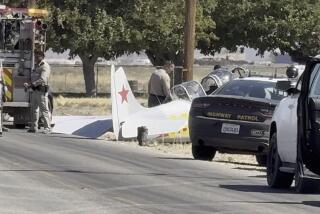‘Small Aircraft as Big Peril’
- Share via
I have just read an article by Gregg Easterbrook in the Opinion section (Sept. 6). I am amazed and severely disappointed that The Times, which usually does an acceptable job of reporting aviation, would even print this article.
The public is afraid of anything it doesn’t understand and can’t control. Sitting in the cabin of an airliner brings out this fear in many people. Easterbrook is trying to focus this fear on a group (small aircraft, or is it deregulated skies, who could tell from the headline) that has very little to do with the problems of today’s aviation system.
Let’s straighten out some other facts. Not all small aircraft are private and not all large aircraft are commercial. Many aircraft operated by commuter airlines, charter companies, and small-package freight companies are smaller than many aircraft owned and operated by individuals and businesses for private purposes. The small Cessna you see landing at your local airport may be carrying mail, your canceled check, Grandma, or it could be an air ambulance flight. The Boeing 727 right behind may be a corporate aircraft carrying executives from a company here to do business with the company you work for. The size of an aircraft has little to do with the service it may be providing for you. One of the most important features of our air traffic system is that access is guaranteed to everyone on a first-come, first-served basis--not just to those who can afford to pay the most for the service.
The recent expansion of the Los Angeles Terminal Control Area has little to do with the problem of midair collisions but a lot to do with the public perception that their government is doing something to save them from sudden and fiery death at the hands of some rogue pilot in a small plane.
This, however, is insignificant when compared to the closing of the Visual Flight Rules corridor over the top of the Los Angeles International Airport. This corridor was established to allow aircraft to cross the approach and departure path of Los Angeles International Airport over the runways where the aircraft are on the ground. The limits of the corridor were the shoreline and the San Diego Freeway, between the altitudes of 2,500 and 5,000 feet. The traffic through this corridor has never been a hazard to traffic operating in and out of LAX. This action was precipitated by a near-collision report from an airliner and a small aircraft many miles from the VFR corridor.
As it turns out, the small aircraft was not seen on air traffic radar because of a blind spot caused by buildings at LAX that have gone up since the radar was installed. Of course this has nothing to do with the VFR corridor but the uninformed public thinks because it is now closed to all aircraft that this will not happen again. I’ve got news for you: the blind spots in the radar system are still there and in fact blind spots exist in all radar systems.
Easterbrook’s conclusion that because two airliners have had midair collisions with small aircraft (not private, the Cessna in the San Diego crash was being flown by a working professional pilot) that this fact alone makes private aircraft the biggest current peril in U.S. commercial aviation. This is, of course, ridiculous. If you use Easterbrook’s logic you will see that gravity is the biggest peril in U.S. commercial aviation today. Also Easterbrook fails to mention that the National Transportation Safety Board, whose job it is to determine what happened in aircraft accidents, did not blame the small aircraft in either of the two midair collisions.
Air traffic has grown significantly since deregulation, to the benefit of everyone, yet the air traffic system has lagged behind in new controllers, modernization and airport construction. There are many problems to be worked out but none of them are insurmountable.
The American public should realize they have the safest and most economical air traffic system in the world.
KNUTE JOHNSON
Sylmar
More to Read
Sign up for The Wild
We’ll help you find the best places to hike, bike and run, as well as the perfect silent spots for meditation and yoga.
You may occasionally receive promotional content from the Los Angeles Times.






